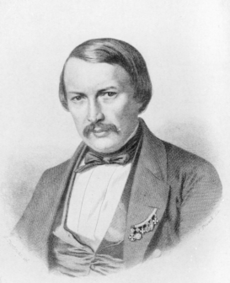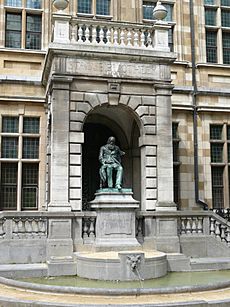Hendrik Conscience facts for kids
Quick facts for kids
Hendrik Conscience
|
|
|---|---|

Conscience, painted in 1870
|
|
| Born | 3 December 1812 Antwerp, French Empire (modern Belgium) |
| Died | 10 August 1883 (aged 70) Ixelles, Brussels, Belgium |
| Resting place | Schoonselhof cemetery, Antwerp |
| Occupation | Soldier, revolutionary, writer, poet, novelist |
| Literary movement | Romanticism |
| Notable works | The Lion of Flanders |
Hendrik Conscience (born December 3, 1812 – died September 10, 1883) was a famous Belgian author. He is known as the person who started Dutch-language literature in Flanders. This was a time when the French language was mostly used by important people in Belgium, in books, and in the government.
Conscience was a soldier in the Belgian Revolution in 1830. He was also a well-known writer who used the Romanticist style, which was popular in the early 1800s. His most famous book is The Lion of Flanders (1838). This book tells a story about a Flemish peasant army winning against French knights at the 1302 Battle of the Golden Spurs. This event was part of the Franco-Flemish War.
During his life, Hendrik Conscience wrote more than 100 novels and short stories. He became very popular. After he died, his books were not as trendy because the Romantic style became less popular. However, his works are still seen as important books in Flemish literature.
Contents
Early Life
Growing Up
Hendrik's father, Pierre Conscience, was French and worked for Napoleon Bonaparte's navy. In 1811, he became a harbourmaster in Antwerp, which was part of France back then. Hendrik's mother, Cornelia Balieu, was Flemish and could not read or write.
After the French left Antwerp in 1815, Pierre Conscience stayed. He was a bit unusual and started a business buying and taking apart old ships. He also collected old, unsellable books. Young Hendrik grew up surrounded by these books, which filled his imagination with exciting stories.
Family Changes
In 1820, Hendrik's mother passed away. He and his younger brother were left with their strict father. In 1826, his father married again, to a younger woman named Anna Catherina Bogaerts.
Hendrik loved to read. He spent his days exploring the old, dusty books in their shop. Later, his father sold the shop and moved to the Campine (Kempen) region. This is a flat, quiet area between Antwerp and Venlo that Hendrik often wrote about. The boys would stay there with their stepmother for weeks while their father traveled to buy ships.
Becoming a Writer
When he was 17, Hendrik left home to work as a tutor in Antwerp and continue his studies. But the Belgian Revolution of 1830 soon interrupted his plans. He joined the Belgian army and fought in several battles. After the Ten Days' Campaign in 1831, he became a sergeant-major. In 1837, he left the army.
While in the army, he met many different people and learned about their lives. He thought about writing in Dutch, even though many people believed Dutch was not suitable for literature. French was the language of educated people and rulers in Belgium.
Even though the Netherlands, just across the Scheldt river, had a long history of Dutch literature, people in Belgium still preferred French. When Belgium became independent in 1831, French was chosen as the national language. Hendrik Conscience felt strongly about writing in Dutch. He once wrote: "I find the Flemish language incredibly romantic, mysterious, deep, strong, even wild. If I ever get the chance to write, I will dive headfirst into Flemish writing."
His Works and Career
While he was a soldier, Hendrik wrote poems, but they were all in French. After leaving the army, he had no job and returned to his father's house. He then decided to write in Dutch. He was inspired by a passage from Lodovico Guicciardini and wrote a series of short stories about the Dutch Revolt. This work was called In 't Wonderjaer (1837). He paid to publish it himself, which cost him almost a year's salary.
The Lion of Flanders
His father was so upset that Hendrik wrote a book in Dutch that he kicked him out of the house. Hendrik arrived in Antwerp with only two francs and a few clothes. Luckily, an old school friend helped him. Important people, like the painter Gustaaf Wappers, became interested in him. Wappers even gave him clothes and introduced him to King Leopold I. The King ordered In 't Wonderjaer to be placed in every Belgian school library.
With the King's support, Conscience published his second book, Fantasy, in 1837. He also got a small job in the provincial archives, which helped him financially. In 1838, he had a huge success with his historical novel, De Leeuw van Vlaenderen (The Lion of Flanders). This book is still considered one of his best works and had a big impact beyond just literature. Even though the book sold well, the high printing costs meant Conscience didn't earn much money from it.
In the 1800s, many writers and artists in Europe were creating stories about heroes from their country's history and myths. They wanted to make these characters symbols of national pride. With The Lion of Flanders, Conscience did this successfully with Robert of Bethune. Robert was a son of the Count of Flanders and a crusader. More importantly for Conscience, he was a key figure in the fight to keep Flanders independent.
Some historians say Conscience made historical mistakes in his book. For example, he showed his hero fighting in the Battle of the Golden Spurs, but Robert of Bethune was not actually there. Also, in real life, "The Lion of Flanders" and his father did not speak Dutch. Still, Robert of Bethune is seen as a symbol of Flemish pride and freedom because of Conscience's romantic story. Conscience's book also inspired De Vlaamse Leeuw ("The Flemish Lion"), which became the unofficial song of Flemish nationalists and is now the official anthem of Flanders.
Later Works
After The Lion of Flanders, Conscience wrote many other books, including How to become a Painter (1843), What a Mother can Suffer (1843), Siska van Roosemael (1844), Lambrecht Hensmans (1847), Jacob van Artevelde (1849), and The Conscript (1850). During these years, he had different jobs, even working as a gardener for a while. Eventually, he became the secretary for the Academy of Fine Arts in Antwerp. It took a long time for his books to sell enough for him to be financially independent.
However, his ideas about writing in Dutch became popular. In 1841, at a meeting in Ghent, Conscience's writings were praised as the start of a national literature. People who loved their country encouraged others to read his books. Each new book by Conscience was celebrated as an honor for Belgium.
In 1845, Conscience was made a Knight of the Order of Leopold. Writing in Dutch was no longer seen as something common or vulgar. Instead, the language of everyday people became almost fashionable, and Flemish literature began to grow.
In 1845, King Leopold I asked Conscience to write a History of Belgium. After that, he returned to writing stories about Flemish home life, which became the most valuable part of his work. He was at the peak of his writing career. Books like Blind Rosa (1850), Rikketikketak (1851), The Poor Gentleman (1851), and The Miser (1853) are among his most important novels. These books influenced many other writers, and Conscience had many people who tried to write like him.
Final Years
In 1867, King Leopold created a new job for Conscience: keeper of the Royal Belgian museums. He continued to write novels regularly, publishing nearly eighty books in total. By this time, he was one of the most respected citizens of Antwerp. His 70th birthday was celebrated with public parties. After a long illness, he passed away at his home in Antwerp. He received an official funeral and was buried at the Schoonselhof cemetery in Antwerp. His tomb is now a monument honoring the great writer.
Awards and Recognition
- 1845: Knight in the Order of Leopold.
- Grand officer in the Order of Leopold.
- 1853: Knight in the Albert Order.
- 1853: Knight of the Order of Vasa.
- 1869: Member of the Royal Academy of Science, Letters and Fine Arts of Belgium.
See also
 In Spanish: Hendrik Conscience para niños
In Spanish: Hendrik Conscience para niños
- Flemish literature
- Belgium in the long nineteenth century




